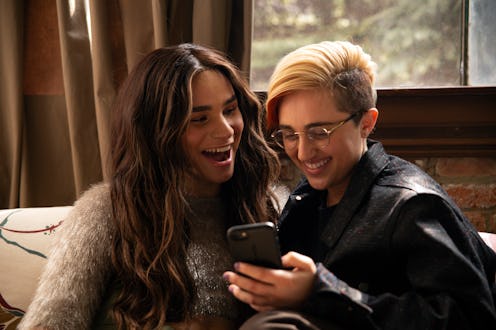As the coronavirus crisis drags on, the disproportionate dangers of COVID-19 for marginalized communities are clear. While experts don't have data about the effects of the pandemic on queer folks, they agree that COVID-19's impact on LGBTQ people is likely harsher than it is on their straight, cisgender peers. In the midst of painful circumstances, however, many queer people are finding ways to create joy..
"Figuring out how to survive, between Black Lives Matter and COVID, feels impossible," says Les, 30. "But surrounding myself with chosen family as much as I can — including at protests — and laughing as often as I can is a form of resistance. My survival and my joy in the face of white supremacy are radical."
A lot of queer folks are seeking solace in small moments of happiness. "As a trans person, I’m thriving during this time," says Tanner Arnold, a customer experience analyst who works for the software company Intuit. "If I’m having a dysphoric day, I don’t go on camera during a meeting, and Zoom allows me to upload my favorite image of myself instead. I haven’t had to worry about a public restroom in months. I have not had to worry about running into any old colleagues who 'didn’t get the memo.' I’m able to just work."
Not everyone gets to be able to safely work from home, of course. "Despite the common argument that the pandemic is somehow an equalizer, what it ultimately does is reveal the profound vulnerability of oppressed people," says Miranda Schreiber, a researcher at the University of Toronto's postgraduate medical education department. "LGBTQ+ people, especially those of color or those who are disabled, are at heightened risk of getting COVID in the first place," Schreiber tells Bustle, because of the way oppression harms people's health. "We’re more likely as a community to have immunocompromising conditions like HIV, eating disorders, or cancer, and more likely to have chronic health conditions."
COVID-related risks are not limited to the virus itself, especially in marginalized communities. For example, half of all trans and nonbinary people experience sexual assault at some point in their lives, including when they're young and living at home. "If someone is quarantined at home with an abuser, maintaining connection with the outside world is key," says NYC-based Talkspace therapist CJ Everhart, L.M.H.C. "Making a priority to connect via Facetime or Zoom with people who are invested in their well-being is vital." That kind of powerful community formation is exactly what many LGBTQ people are focusing on during the pandemic.
"Lots of queer spaces have adapted to the constraints of COVID really brilliantly, like moving LGBTQ+ book clubs to Zoom or creating online events like Club Quarantine," Schreiber says. "Pride is also happening online in a lot of cities. Many events for BIPOC queer people have also moved online. Disabled queer people who didn’t have adequate access to Pride in the past finally have the opportunity to participate more fully."
The Center in New York City has begun documenting these queer experiences with their new The LGBTQuarantine Archive Project, says Caitlin McCarthy, the Center's archivist. "Queer resilience and joy perfectly encapsulates the contributions [to the Project] we've gotten so far," they tell Bustle. The Center is inviting LGBTQ people to submit selfies, video diaries, snippets of writing, memes, and whatever else captures your queerantine experiences.
"There's so much wisdom to be found," McCarthy says of the richness of LGBTQ lives in quarantine. "Our queer elders and disabled fam show us how connection transcends physical space," they tell Bustle. They describe one contribution as "joyous Zoom art" submitted by one half of a couple. He wrote about how he and his partner of 36 years draw strength from each other: "[We] know we have weathered [worse] and with our love can hopefully weather this one also," he told the Center.
McCarthy describes another contributor to the Project, an autistic net artist, who has been building a site showcasing "how queer folks access information technology communities and how the community has responded to the epidemic with online support."
Other LGBTQ people are turning to visual art during quarantine, McCarthy says. They tell Bustle about a trans femme artist who is drawing daily self-portraits in response to the Project's prompt, "What are you drawing hope or strength from right now?" This trans femme told the Center, "the only way we can get through this is together. The only way I can personally get through this is sober. I can use this time to make art, personal art, bad art, art you won't ever see, art that satisfies only my tastes. [I get] strength from the fact that all I need resides within me.'"
Even if someone feels isolated, they're not by themselves. "Find the people who get you, and don’t ever let them go," Arnold says. "When it’s safe to do so, reach out to your chosen family for some reassurance. Find the things that bring you joy, even silly things like looking at Corgi puppies on Instagram. Do your best to carve out some space for yourself. Most importantly, remember that you are not alone and you are loved. If things get really bad, call the crisis hotlines. Just don’t give up."
Experts:
Tanner Arnold, customer experience analyst, panelist at the first Trans Summit at Intuit
Miranda Schreiber, researcher, University of Toronto postgraduate medical education department
CJ Everhart, LMHC, Talkspace therapist
Caitlin McCarthy, archivist, The LGBT Community Center in New York City
